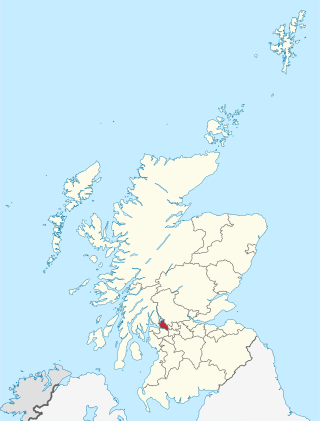Related Research Articles

West Dunbartonshire is one of the 32 local government council areas of Scotland. The area lies to the north-west of the Glasgow City council area and contains many of Glasgow's commuter towns and villages. West Dunbartonshire also borders Argyll and Bute, East Dunbartonshire, Renfrewshire and Stirling.

East Dunbartonshire is a county constituency of the House of Commons of the Parliament of the United Kingdom (Westminster). It elects one Member of Parliament (MP) by the first past the post system of election. The seat is possibly best known for formerly being the constituency of Jo Swinson, the former Leader of the Liberal Democrats who was defeated at the 2019 general election. The current MP for the constituency is Amy Callaghan of the Scottish National Party (SNP).

West Dunbartonshire is a county constituency of the House of Commons of the Parliament of the United Kingdom. It elects one Member of Parliament (MP) by the first past the post system of election and covers the same area as the county of West Dunbartonshire.
Argyllshire was a county constituency of the House of Commons of the Parliament of Great Britain from 1708 to 1800 and of the House of Commons of the Parliament of the United Kingdom from 1801 until 1983. The constituency was named Argyll from 1950. The constituency was replaced in 1983 with Argyll and Bute.
Edinburghshire was a Scottish county constituency of the House of Commons of the Parliament of Great Britain from 1708 to 1801 and of the Parliament of the United Kingdom from 1801 to 1918.
Midlothian and Peebles Northern was a county constituency represented in the House of Commons of the Parliament of the United Kingdom from 1918 until 1950. Along with Peebles and Southern, it was formed by dividing the old Midlothian constituency.
Forfarshire was a Scottish county constituency represented in the House of Commons of Great Britain from 1708 until 1800, and then in the House of Commons of the United Kingdom until 1950.
South Ayrshire was a county constituency of the House of Commons of the Parliament of the United Kingdom from 1868 until 1983, when it was abolished. It returned one Member of Parliament (MP), elected by the first past the post voting system.
Bothwell was a county constituency in Lanarkshire represented in the House of Commons of the Parliament of the United Kingdom from 1918 to 1983. It was formed by the division of Lanarkshire constituency.
Hamilton was a burgh constituency represented in the House of Commons of the Parliament of the United Kingdom from 1918 to 1997. It elected one Member of Parliament (MP) by the first past the post voting system.

West Renfrewshire was a county constituency of the House of Commons of the Parliament of the United Kingdom from 1885 to 1983 and again from 1997 until 2005. In 2005 the constituency was abolished and the area is now represented by Inverclyde, Paisley and Renfrewshire North and Paisley and Renfrewshire South.
Motherwell was a burgh constituency represented in the House of Commons of the Parliament of the United Kingdom from 1918 to 1974. It was formed by the division of Lanarkshire. The name was changed in 1974 to Motherwell and Wishaw. It is famous for returning the first-ever SNP MP and arguably the first Communist Party MP.
Kilmarnock Burghs was a district of burghs constituency of the House of Commons of the Parliament of the United Kingdom from 1832 to 1918. It elected one Member of Parliament (MP) by the first-past-the-post voting system.
Dunbartonshire was a county constituency of the House of Commons of Great Britain from 1708 to 1801 and of the House of Commons of the Parliament of the United Kingdom from 1801 to 1950.
Bute and Northern Ayrshire was a county constituency of the House of Commons of the Parliament of the United Kingdom from 1918 to 1983. It elected one Member of Parliament (MP) by the first past the post voting system.
Angus North and Mearns was a county constituency represented in the House of Commons of the Parliament of the United Kingdom from 1950 to 1983. It elected one Member of Parliament (MP) by the first past the post voting system.
Kincardineshire was a constituency of the House of Commons of the Parliament of Great Britain from 1708 to 1801 and of the Parliament of the United Kingdom from 1801 to 1918. It was represented by one Member of Parliament (MP).
Ayr Burghs was a district of burghs constituency of the House of Commons of the Parliament of Great Britain from 1708 to 1800 and of the House of Commons of the Parliament of the United Kingdom from 1801 to 1950. It elected one Member of Parliament (MP), using the first-past-the-post voting system.
Dunfermline Burghs was a burgh constituency of the House of Commons of the Parliament of the United Kingdom from 1918 until 1974. It elected one Member of Parliament (MP) using the first-past-the-post voting system.
Peebles and Southern Midlothian was a county constituency of the House of Commons of the Parliament of the United Kingdom (Westminster) from 1918 to 1950. It elected one Member of Parliament (MP) by the first past the post voting system.
References
- ↑ Leigh Rayment's Historical List of MPs – Constituencies beginning with "D" (part 4)
- ↑ Whitaker's Almanack, 1920
- 1 2 3 4 5 6 7 8 Craig, F.W.S., ed. (1969). British parliamentary election results 1918-1949 . Glasgow: Political Reference Publications. p. 576. ISBN 0-900178-01-9.
- 1 2 The Times, 8 December 1923
- ↑ Oliver and Boyd's Edinburgh Almanack, 1927
- ↑ Whitaker's Almanack, 1934
- ↑ Whitaker's Almanack, 1939